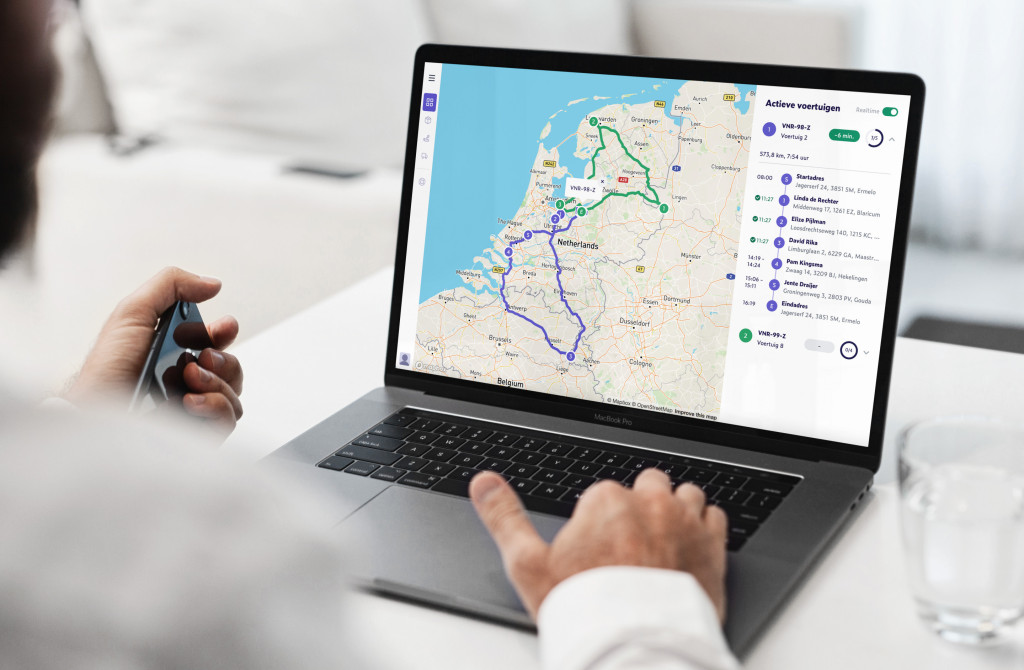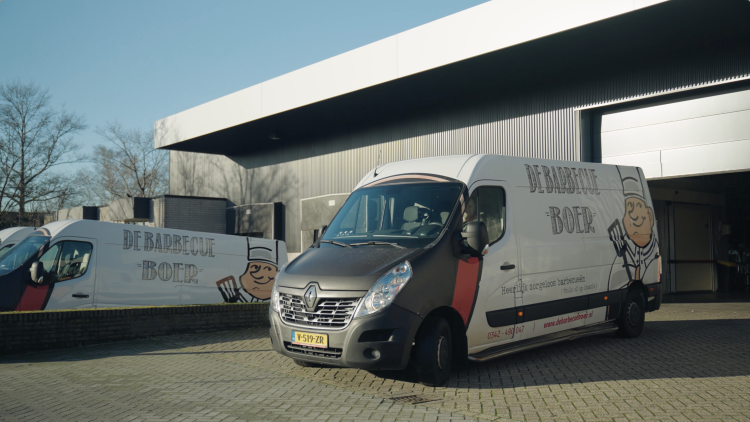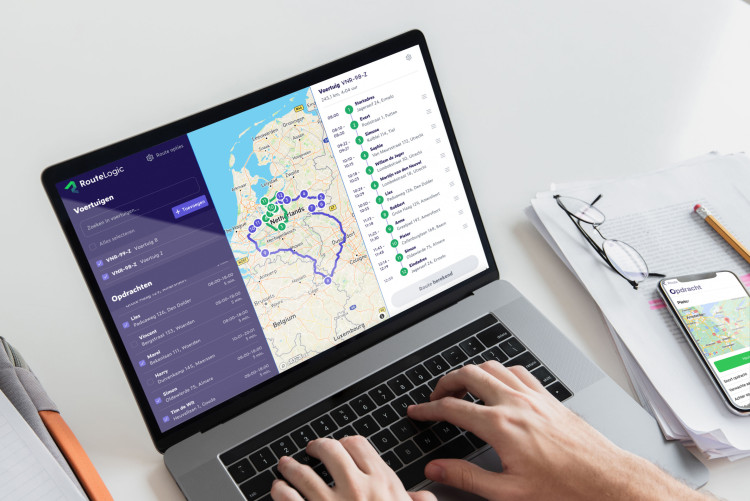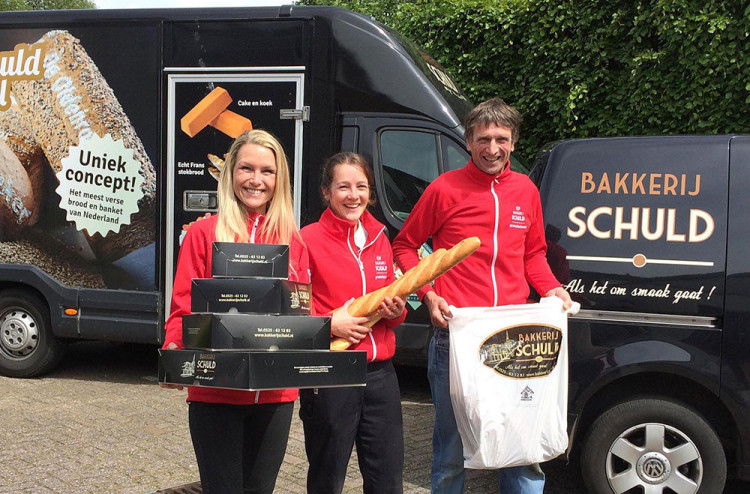Zero-emission will become the standard in around 30-40 city centres
From 1 January 2025, a lot is going to change if you deliver goods in the city centre with a van or truck running on petrol or diesel. With this, municipalities want to reduce CO2 emissions in cities.
Zero-emissions will become standard in about 30-40 city centres, how do you prepare? We answer all your questions in this article. So that your delivery service is ready for the upcoming zero-emission zones in city centres.
What is a zero-emission zone?
From 1 January 2025, municipalities may designate an urban area where no polluting vans or trucks are allowed to operate. These are vehicles that run on petrol or diesel. In zero-emission zones, you will only be allowed to drive your van or truck if it does not emit pollutants. These are vehicles running on electricity or hydrogen. A zero-emission zone is in circumference at least the city centre plus surrounding neighbourhoods.
Why are cities introducing zero-emission zones?
Cities will become cleaner, healthier and more pleasant to live in this way. Zero-emission zones are expected to save around 1 billion kilograms of CO2 emissions per year by 2030. Zero-emission zones thus make an important contribution to climate goals.
The introduction of zero-emission zones also presents challenges. Entrepreneurs and owners of SMEs for which transport is part of their business (think painters, installers and plumbers) will have to deal with it, but so will companies that deliver their own orders (caterers, construction and garden-related companies and e-commerce parties). How will you soon get a picnic table, beech hedges and trees or construction materials into a zero-emission zone? We looked into it for you.
Who does a zero-emission zone apply to?
A zero-emission zone applies to business logistics. This covers trucks, vans and commercial vehicles that must drive emission-free within these zones.
Is a zero-emission zone the same as an environmental zone?
Please note! A zero-emission zone is not the same as an environmental zone. This is because an environmental zone is an area where certain diesel vehicles are not allowed to enter. Unlike an environmental zone, a zero-emission zone applies only to business logistics.
These 40 municipalities signed the Climate Accord for zero-emission zones
The Climate Accord has been signed by 20 municipalities. By signing the Climate Accord, they are indicating that they will only allow zero-emission supply to city centres by 2025. Some 30-40 municipalities are expected to eventually join the signed Climate Accord.
In the first phase, these cities signed the Climate Agreement: Amsterdam, Amersfoort, Assen, Delft, Eindhoven, Groningen, Haarlem, Leiden, Nijmegen, Rotterdam, Tilburg, Utrecht, Zwolle and 's-Hertogenbosch. Later, Alphen aan de Rijn, Apeldoorn, The Hague, Deventer, Dordrecht, Ede, Enschede, Gouda, Hilversum, Maastricht and Schiphol Airport (per 1-1-2026) also joined. Almere, Hoorn and Zaanstad are still in the research phase.
In Amsterdam, an emission-free zone for vans and trucks will be established within the ring road from 2025.
Some municipalities including Zutphen are going a step further. Zutphen wants to have the entire inner city emission-free by 2025. Not all cities will have zero-emission zones. A substantial proportion of the approximately 350 municipalities in the Netherlands are not introducing a zero-emission zone for the time being.An up-to-date overview of zero-emission zones in the Netherlands can be found here.
When will I know which city centres I am still allowed to enter or not?
Cities have jointly agreed to indicate that they will implement the emission-free zone four years before it takes effect. The municipality or cities will indicate the geographical boundaries of the area and its relation to any environmental zone. All new vans and trucks registered from Jan. 1, 2025 must be zero-emission to enter zero-emission zones. This does not apply to vans and trucks already on the road, for which this will not apply until January 1, 2030.

Bron: https://www.opwegnaarzes.nl
Will there be a transitional regime?
On 5 October 2020, Minister Van Veldhoven - Van der Meer informed the chamber about the agreements made on a national transitional regime for vans and trucks. To avoid contradictory national and local rules.
The minister also indicated that she considers it important to make it practical, feasible and affordable for entrepreneurs to switch from investing at a natural time.
What is the transitional arrangement for vans?
Vans with emission class 5 have unlimited access to zero-emission zones for urban logistics until 1 January 2027. Vans with emission class 6 have unrestricted access until 1 January 2028.
What are the transitional arrangements for trucks and box trucks?
Euro 6 rigids, if they are not older than 5 years on 1 January 2025, can drive in emission-free zones until 1 January 2030.
For Euro 6 trucks, if they are not older than 8 years on 1 January 2025, they can drive in emission-free zones until 1 January 2030. This also applies to PHEV (Plug-in Hybrid) trucks, provided they can demonstrate that they drive emission-free in these zones.

Are there further exceptions possible?
Yes in a number of cases customisation is possible. Consider, for example, these situations:
- If there are financial reasons, which are brought disproportionately to make the switch to zero-emission vehicles, more time can be granted for this.
- For specific uses for which a zero-emission vehicle is not yet available.
Subsidy for entrepreneurs on purchase of zero-emission van
The government has set the goal of completely clean road traffic (zero-emission transport) by 2050. As an intermediate step, by 2025, 30 to 40 city centres will have zero-emission zones in place. This is a big step for both the climate and entrepreneurs. To encourage the purchase of zero-emission vans, there is a subsidy scheme. The purchase price of an electric van or hydrogen van is higher than a comparable diesel/petrol van.
Entrepreneurs can count on financial support. The scheme aims to accelerate the uptake of emission-free vans. The full subsidy scheme can be found here.
In a nutshell, it means that vans from €20,000 qualify for a subsidy of 10% of the purchase price (net catalogue price) up to a maximum of €5,000 per vehicle. However, there are some conditions:
- The vehicle must be owned for at least three years.
- The agreement has not been concluded before 1 January 2021.
- The company car is not yet registered at the time of the application for subsidy.
- The vehicle must have a range of at least 100km.
Besides this subsidy scheme, as an entrepreneur you can also make use of the MIA scheme. As an entrepreneur, you can apply for the subsidies on the website of Rijksdienst voor Ondernemend Nederland.
[Tag:Why switch to zero-emission vehicles now]
Why switch to zero-emission vehicles now
- Residual value of your current vehicles (these are going to drop rapidly).
- Governments will set zero emission requirements in tenders, procurement and licensing to encourage and reward this.
- There are now subsidy schemes that reduce the purchase price of zero-emission vehicles.
Should I switch to an electric vehicle now or are there other options?
There are 2 types of zero-emission vehicles that are eligible to respond to emission-free zones. The best known are electric vehicles. There is also another category of vehicles under development, the hydrogen or hydrogen van or truck. Both have zero-emission propulsion.
What alternatives are there for delivering orders in city centres?
Many parties are working on making the last mile in cities emission-free. While some alternatives are in a test phase, others are well advanced and successfully implemented. We list a number of initiatives.
 Source: https://topsectorlogistiek.nl
Source: https://topsectorlogistiek.nl
ULaaDS
Instead of vans picking up parcels at an out-of-town sorting terminal, driving to the city center and spending all day delivering parcels, containerization introduces standardized and modular loading units, such as dedicated last-mile trolley containers. Multiple parcels can be placed in these containers at the sorting terminal and then transported to city hubs, where the containers are transferred to last-mile delivery vehicles. This pilot is being done by Groningen and a few more affiliated cities. This example is explained in a bit more detail here: https://ulaads.eu/containerised-urban-last-mile-delivery
Crowdsourcing logistics
In crowdsourcing logistics, delivery is not carried out by a dedicated logistics provider, but by ordinary citizens (individually or collectively) They make the shipment of parcels coincide with their usual routes, using their own means of transport (from bicycles to a motorbike or car).
City-wide logistics platform
All urban delivery capacities run on a single platform, organised and managed neutrally by themselves, a city company, a third party or as a public-private partnership (PPP). The platform pools the flow of goods between all providers and uses decentralised warehouses to optimise last-mile deliveries, while the city defines the framework within which the platform can operate (e.g. criteria for selection, regulatory interventions).
Pakketkluizen
Door pakketkluizen op locaties te plaatsen binnen, buiten of aan de rand van de emissievrije zones, is het voor bestelbussen en vrachtwagens niet meer nodig om de zone te betreden. Consumenten kunnen hun pakket ophalen bij de pakketkluis die op route ligt van hun woon-werk verkeer of waar zij sowieso toch al langs zouden komen.
Utilising excess capacity
Carriers already operating emission-free vehicles can offer their excess capacity and take orders for others. Making better use of already available capacity.
Initiatives like https://www.movertransport.com/en/dk/ are emerging that let you easily book a transporter.
Cityhubs
De grote logistieke partijen (DHL, PostNL, UPS) hebben tegen de stadscentra zogenoemde Cityhubs gebouwd of bouwen die de komende jaren. In een Cityhub worden pakketten aangeleverd uit een ander distributiecentrum. Vanuit daar vervoeren zero-emissie voertuigen (bijv. bestelwagens, (bak)vrachtfietsen, vervoer over water of light electric vehicles (LEV), de bestellingen naar de adressen in de zero-emissiemissie zones. Voor kleine en lichte pakketten een prima oplossing. Wel zal het een stuk kostbaarder worden om op deze manier pakketten te distribueren. Door het aantal extra handelingen is de kans op fouten groter en zijn de kosten hoger.
Last mile Food & Special delivery
The above solutions are a great alternative for some deliveries. However, they also have their drawbacks. You are no longer fully in control of the experience you want to give your customers. After all, in some alternatives, you no longer go to your customer's door yourself. In addition, the radius of action of a refrigerated truck / van with cooling is still very limited. The range of refrigerated delivery is about 50-100 kilometres and because this is so limited, this does present some challenges.
You also run into some challenges with delivering large/heavy products. Not every mode of transport can bring this into the inner cities and unloading and loading such products increases handling costs and the chances of something being damaged. If you deliver food, it should preferably be stored and transshipped under refrigeration. Apart from the extra handling (which also entails costs), adding such a step in the logistics process also increases the risk of mistakes. A parcel is forgotten, sits too long outside the refrigerator or is not delivered for some other reason. In addition, it becomes complex to organise communication to your customer properly and to keep track of temperature logs, for instance. Reason for many food last mile delivery companies or companies that deliver heavy and complex goods to continue to do this themselves.
How will you soon deliver your orders yourself?
There are many initiatives, solutions devised or in the testing phase to take care of the last mile for you. But how do you handle it if your orders are not suitable for it? For instance, the products you deliver are heavy or large, fragile or you want to provide on-site service.
Some segments that have to deal with this: hospitality, facilities, construction, renovation, parcel market and home deliveries, supermarket delivery and corporate waste collection. We list some possibilities.
Green part of your fleet
To be able to deliver to the zero-emission zones yourself in the city centres soon, you need to start using zero-emission vehicles. There is no escaping this. However, you can choose not to electrify your entire fleet.
To cover longer distances, it is necessary to have vehicles with a long range at your disposal. Missions outside the zero-emission zones can be combined and taken away using a petrol or diesel vehicle. Basically as you are used to now. You can also combine the addresses you deliver in zero-emission zones. For these assignments, however, you choose a zero-emission vehicle. In terms of planning, of course, this is quite a puzzle. Software can help you with this and make the right distribution of assignments between types of vehicles.
Work with specialised carriers
If you don't often deliver to city centres or if you only get there sporadically, it pays to outsource these orders. You can deliver the order yourself to a Cityhub or to the carrier that delivers it to city centres for you.
Open your own hubs at various locations around the country
Another way to still be able to green your fleet is to open some hubs of your own in the Netherlands. If you choose the hubs well, close to areas where you deliver a lot, it is no problem to deliver in the zero-emission zones yourself.
Parties like DHL have also arranged their routes this way. They drive in the morning from the distribution centre or Cityhub to the delivery area (usually limited to 30 km). During the day, they drop off all parcels in a 15-kilometre radius and at the end of the working day they drive back to the starting location. As few kilometres are driven in a day, this can be done on one battery charge. However, the driver is busy all day. Once his working hours are over, he drives back to the depot and recharges the vehicle at night for another day. You then drive without having to recharge.
.How do you combine urban logistics with rural logistics?
Companies that deliver orders across the country, and need to be in cities when doing so, face a challenge. With the upcoming zero-emission zones, you can no longer combine this without zero-emission vans. When your products are fragile, heavy or large, you also prefer not to give them to an external logistics party. Especially if you find it important to deliver the product yourself and still perform service on site (e.g. assembling or unpacking the delivered product). What are your options.
Separate city and out-of-town addresses
Now you are still combining your routes. The orders destined for the urban area where zero-emission zones will soon be introduced, you take them with the same diesel/petrol van as your orders outside these zones. Your route thus has a high density.
In the new situation, this is no longer possible, as you simply cannot enter a zero-emission zone with a non-zero-emission vehicle. By making a distinction between addresses inside and outside a zero-emission zone, you can take them away with separate vehicles. The addresses outside the zero-emission zone are taken away with a diesel/petrol delivery van. These have a high action radius so you can easily cover long distances and, if necessary, fill up quickly en route.
You can then purchase zero-emission vehicles for addresses in the city. In many cases, it is possible to combine a number of cities. For instance, you could have a 30km radius around Amsterdam and use this vehicle to deliver all addresses in this region. You will then be able to deliver to places such as Haarlem, Zaandam, Weesp and Mijdrecht. The range of electric vans already makes this possible.
 Source: https://topsectorlogistiek.nl
Source: https://topsectorlogistiek.nl
But how do you plan a good and efficient route in this situation?
It is important to establish a relationship between the assignment and the vehicle. In RouteLogic, it is possible to work with tags. You link a tag to a task and to a vehicle. As an example, you could create a tag "emission zone" for all assignments that fall within the zero-emission zone. Then you give the same tag to your zero-emission vehicle. RouteLogic does the rest for you. RouteLogic automatically establishes the relationship between an assignment in a zero-emission zone and an appropriate vehicle. All addresses outside the zone are automatically placed in the other available (non-zero-emission) vehicles.
On-the-go charging
Another option you might consider. Fully convert your fleet to zero-emission vehicles over the next few years. You still have some time, so are you about to buy a new bus or replace an existing one? Then go for a zero-emission vehicle right away. You will thus change your fleet in a smooth way and keep the investment under control and spread out.
Once your fleet is fully emission-free, you can deliver all your assignments in both emission-free zones and beyond. This will make your planning a lot easier and your routes more efficient. This option does give you another challenge, the range.
Because you are now combining both rural and urban addresses, you are going to cover many more kilometres, and that is where an electric van is not the most ideal solution. En route charging at a fast charger increases your range. You do need to schedule some time for this. It takes about 30 minutes to recharge most vehicles to 80%. If you leave in the morning with a full battery, you will drive about 250-350 kilometres on one charge. After that, you need to start charging your vehicle. With your recharge on the way, you add about 200-250 kilometres more to your day. Your route with an electric vehicle could then still be around 450-600 kilometres in a day. Not bad!
 Source: https://nklnederland.nl
Source: https://nklnederland.nl
Multiple depots
An option that is not easy for every company to realise; drive out orders from multiple depots spread across the country. With four or five strategically chosen depots, you can more easily drive limited range routes with zero-emission vehicles.
You can determine the location of your depots by analysing your current routes. Which regions are you frequent and do a lot of stops? You can then plan a depot in the middle of the region and serve this region. Or if you plan a depot on the outskirts of this region, even serve two regions from one depot. You can have the depots supplied directly from the supplier/products, or you can drive the orders from your main depot to the depots yourself. In that case, make sure your depot is outside an emission-free zone.
If you don't want to go for multiple depots, you could consider transloading orders at some strategic locations around the country. Although this is not ideal because it will cost you extra time, it can work fine as an interim solution until the volume increases. You can then always consider setting up one or more depots.
Exemption C driving licence for zero-emissions vans
From 1 January 2023, drivers with a normal B licence will be allowed to drive zero-emission vehicles up to 4,250 KG. The increase in the permitted driving weight will be allowed because zero-emission vehicles tend to be heavier due to the battery pack or heavier hydrogen tank. There are some requirements though, which you can read further here.
Want to know the cost of electric charging on your drive?
Then take a look at: https://www.electricchargingnl/#/home. In this online simulator, you can enter a journey that is representative for you. You will then see the approximate cost of such a trip with an electric vehicle.
What electric vans are on the market now?
To arrive at a suitable choice, it is important to know which electric vans are already on the market. We have created a comprehensive overview for you. You will find purchase prices and action radiusses, but also load and towing weights and, for example, how long it takes to charge a vehicle. Here you will find the entire overview of electric vans on the current market.
Is there route optimisation software electric vans?
Fortunately, there is. With RouteLogic, you can easily plan all your assignments in regular vans, electric vans only or combined. RouteLogic will also indicate whether an address is in or outside a zero emission zone. This allows you to automatically plan all your assignments in a suitable vehicle. So you can be sure that assignments in a zero-emission zone will only be scheduled in a suitable vehicle.
But there's more. RouteLogic also ensures that charging stations are included in route planning based on your range. As a planner and as a driver, you therefore see exactly where to charge and for how long. It also remains possible to communicate a good arrival time to customers because we include the charging time in the times you communicate.
- Automatically include available charging stations in your routes
- Clear loading instructions for your drivers
- Clear communication to your customers with correct ETA including loading time
- Automatic visibility of whether an address is inside or outside a zero-emission zone
- Automatic scheduling of zero-emission addresses in zero-emission vehicles
- Possibility of multiple charging on the road
- Taking into account smart charging strategies
- Possibility of planning mixed fleets (diesel and electric) at once
You can read more about route planning with electric vehicles in this blog.



